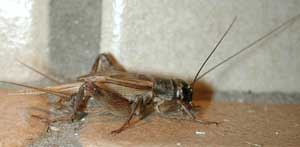– Contributed by Tina Mitchell

Some people offer mealworms as supplements to seed and suet feeders. (Mealworms are the larval stage of a species of darkling beetle.) Mealworms are rather like the “fast food” of the bird world—easy to serve, convenient to eat, and tasty (at least based on bird behavior). But, for a number of reasons, they are not necessarily the best food for birds—especially in the spring and summer, when females need calcium to prepare for egg-laying and nestlings need calcium to build strong bones in a very few days.
A good alternative for those who want to feed supplemental insects to wild birds is crickets. Acheta domesticus (the house cricket) is the species most often sold by vendors. Live crickets can usually be bought in pet stores that stock supplies for reptiles. They can also be kept in a covered aquarium, with a thin floor covering of cut native grasses or timothy hay and overturned cardboard egg cartons for hiding places. Something as simple as quartered potatoes can serve as a food and moisture source.
To offer them for birds, put a handful in a sealable plastic bag, seal it completely, and put the bag in your freezer for about 10 minutes. The crickets will be dead but will still look and feel like the real thing, rather than like cricket-sicles, to the birds. … the back legs of crickets have barbs and can sometimes be a problem for nestlings. But freezing softens the barbs, so they go down easier.
Nutritionally, crickets provide a better balance of necessary nutrients than do mealworms. (See the Grubco Web site for one set of comparisons.) Both provide similar proportions of protein. However crickets contain about 50% less fat and about 10% more moisture—the latter, especially important since insects are the sole source of moisture for most nestlings. House crickets also exist in the wild in considerable abundance in many places—particularly for those living in the east.
However, both mealworms and crickets fall seriously short on the calcium front. Calcium and phosphorus must be available in the diet in about a 2:1 ratio in order for bones to develop properly. But mealworms have a calcium:phosphorus ratio of about .04–which is 50 times more phosphorus than desired, compared to the calcium they offer. Crickets have a calcium:phosphorus ratio double that—but that still comes to a measly .08, which is still 25 times more phosphorus than desirable. This shouldn’t present a serious problem for healthy adults living free, who are also eating and feeding their young a vast range of other insects. Variety is both the spice and the building blocks of life.
But for insects that you offer as supplemental food, an easy fix exists. Dust the insects in powdered calcium carbonate—available inexpensively at grocery and health food stores. For humans, calcium carbonate is not the best or most bioavailable form of calcium; a number of sources recommend calcium citrate instead. But for birds, calcium carbonate is considered a “gold standard” for bioavailability. In addition, calcium carbonate has a concentration of calcium that is about twice that of calcium citrate—so less is indeed more. Finally, calcium carbonate is typically cheaper than calcium citrate.
If you decide to try crickets, start small to see if the birds in your area will recognize your prepared crickets as food. But no matter what insects you might offer birds, dust them in powdered calcium carbonate to balance the really high levels of phosphorus found in them. It will help breeding females, who need extra calcium for egg formation, and the developing bones of the nestlings will thank you for it!
Note from Bet: Tree Swallows and Purple Martins are aerial insectivores, and will not come to a feeder. They both suffer from difficulty hunting flying insects during extended periods of cold wet weather. Some landlords have flipped crickets into the air for these birds to take.
More Information:
―
